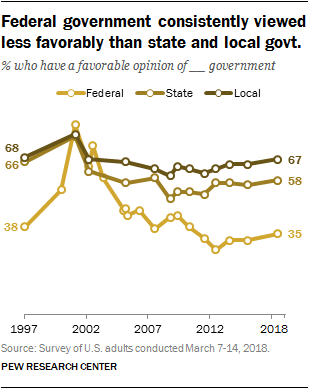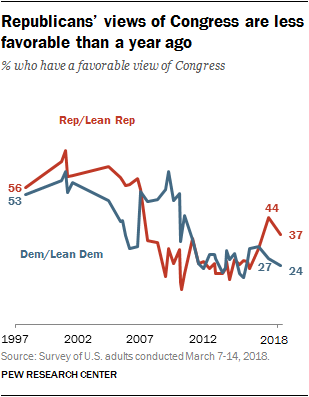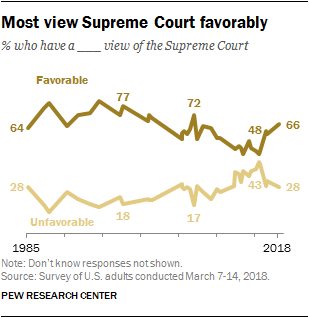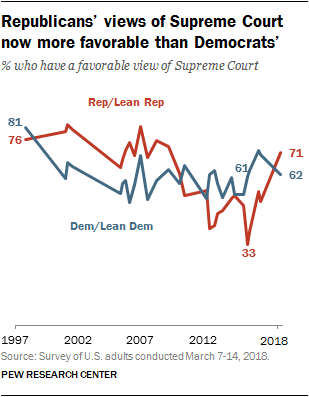
Americans are generally positive about the way democracy is working in the United States. Yet a majority also says that the “fundamental design and structure” of U.S. government is in need of “significant changes” to make it work today.
Republicans are more likely than Democrats to say U.S. democracy is working at least somewhat well, and less likely to say government is in need of sweeping changes.
And far more Republicans than Democrats say the U.S. political system is “best in the world” or “above average” when compared with political systems of other developed nations.
Overall, about six-in-ten Americans say democracy is working well in the U.S. today (18% very well, 40% somewhat well); four-in-ten say it is not working well (27% not too well and 13% not at all well).
About seven-in-ten (72%) Republicans and Republican-leaning independents say U.S. democracy is working very or somewhat well, compared with 48% of Democrats and Democratic leaners. Relatively small shares in both parties (30% of Republicans and just 7% of Democrats) say democracy in the U.S. is working very well.

While a majority of Americans say democracy in this country is working well, about six-in-ten (61%) say significant changes to the fundamental design and structure of government are needed to make it work for current times; 38% say the design and structure of government serves the country well and does not need significant changes.
By roughly two-to-one (68% to 31%), Democrats say significant changes are needed, while Republicans are divided (50% to 49%) over whether or not extensive changes are needed.
Although the view that significant changes are needed is widely held, those with higher levels of political engagement are less likely to say this than people who are less politically engaged.
Overall, those with high levels of political engagement and participation are split over whether significant changes are needed or not (51% vs. 48%). Views that the American system of government needs far-reaching reforms are more widespread among those with lower levels of engagement: 60% of those with a moderate level of engagement say this, along with 71% of those who are relatively unengaged with politics.
This pattern is evident within both partisan coalitions: 40% of Republicans and Republican leaners who are highly engaged with politics say the fundamental design and structure of American government needs significant reform, compared with 60% of low-engagement Republicans. Similarly, while a 57% majority of highly engaged Democrats and Democratic leaners say significant changes are needed, that share rises to 78% of the least politically engaged Democrats.

Across demographic groups, there are only modest differences in the shares saying that democracy is working at least somewhat well, but there are more pronounced differences on whether changes are needed to the fundamental design and structure of government.
Whites (54%) are less likely than blacks (70%) and Hispanics (76%) to say the government needs significant change, but the three groups have similar assessments of American democracy’s performance.
There also are significant age gaps over whether extensive change is needed to the structure and design of government, with 66% of adults younger than 50 saying this, compared with 58% of those ages 50 to 64 and 50% of those 65 and older. But age groups differ little in their evaluations of how well democracy is functioning.
Educational groups also differ little in their overall opinions of how well democracy is working. But those without a bachelor’s degree (65%) are more likely to say the government needs significant change than those with a college degree (54%) or a postgraduate degree (45%).
Americans give their political system mixed grades

When asked to compare the U.S. political system with others in developed countries, only about four-in-ten Americans (41%) say it is “best in the world” or “above average.” Most (57%) say it is “average” or “below average.”
Several other national institutions and aspects of life in the U.S. are more highly rated than the political system. Nearly eight-in-ten (79%) say the U.S. military is either above average or the best in the world compared with militaries in other developed nations – with 38% calling it best in the world.
Larger shares also say the U.S. standard of living, colleges and universities, scientific achievements and economy are at least above average internationally than say that about the political system. Only the nation’s health care system (30% best in the world or above average) and public schools (18%) are rated lower.
Republicans and Republican-leaning independents generally give the U.S. better marks for its performance on these issues than Democrats and Democratic leaners. About six-in-ten Republicans say the country’s political system is above average or the best in the world (58%), compared with about a quarter of Democrats (27%). Republicans also give the country much higher marks than Democrats on its standard of living, health care and economy.

The shares of Republicans and Democrats giving the U.S. high marks on several of these national institutions and aspects of American life have diverged sharply since 2014.
Today, Republicans are about twice as likely as Democrats to say the U.S. political system is above average or the best in the world (58% vs. 27%).
In 2014, about four-in-ten members of both parties gave the political system a positive rating (37% of Republicans, 36% of Democrats); in 2009, identical shares of Republicans and Democrats (52% each) said the U.S. political system was at least above average.
Partisan divides are growing in other areas as well. For example, 61% of Republicans and just 38% of Democrats describe the U.S. economy as best in the world or above average. Partisan differences in these assessments were much more modest in 2014 and 2009.
Little public confidence in elected officials

Americans express little confidence in elected officials to act in the best interests of the public. Just a quarter say they have a great deal (3%) or fair amount (22%) of confidence in elected officials.
That is by far the lowest level of confidence in the six groups included in the survey. Large majorities say they have a great deal or fair amount of confidence in the military (80%) and scientists (79%). In addition, higher shares express confidence in religious leaders (49%), business leaders (44%) and the news media (40%).
Overall public confidence in these groups is little changed since 2016, but in some cases – including elected officials – the views among Republicans and Democrats have shifted.

Though majorities of both Republicans and Democrats continue to express little or no confidence in public officials, Republicans (36%) are more likely than Democrats (17%) to express at least a fair amount of confidence in elected officials to act in the public interest. Two years ago, more Democrats (32%) than Republicans (22%) had confidence in elected officials.
The partisan gap in confidence in the news media also has widened considerably. Today, 58% of Democrats and just 16% of Republicans are confident in the news media to act in the public interest. Since 2016, the share expressing at least a fair amount of confidence in the news media has increased 12 percentage points among Democrats, while falling 13 points among Republicans.
And more Republicans have confidence in business leaders than did so two years (62% now, 51% then). Far fewer Democrats express confidence in business leaders (32%), and their views are little changed from two years ago.
Republicans also express more confidence in the military (92%) than do Democrats (73%), and the gap has not changed much since 2016.
State, local governments viewed more favorably than federal government

Americans have more favorable opinions of their state and local governments than the federal government in Washington. Two-thirds say they view their local government favorably, and 58% have favorable views of their state government. Only 35% of adults report a favorable opinion of the federal government.
Views of federal, state and local government have changed little over the past decade. Favorable opinions of the federal government have fallen significantly since peaking in the wake of the 9/11 terrorist attacks.

While overall views of the federal government in Washington are largely unchanged from late 2015, Republicans and Democrats have moved in opposite directions since then.
Today, 44% of Republicans and Republican leaners have a favorable opinion of the federal government, compared with 28% of Democrats and Democratic leaners. In 2015, views of the federal government were reversed: 45% of Democrats had a favorable view versus 18% of Republicans. Republicans’ and Democrats’ views of the federal government also flipped between 2008 and 2009, when Barack Obama won the presidency.
There are much smaller partisan differences in favorability toward states and local government. Majorities in both parties (61% of Republicans, 55% of Democrats) have favorable impressions of their state government; similar shares in both parties (69% of Republicans, 68% of Democrats) view their local governments favorably.
Views of Congress and the Supreme Court

Views of Congress remain extremely negative: Two-thirds of Americans say they have an unfavorable view of Congress, compared with 30% saying their view is favorable. The share expressing unfavorable views has increased slightly from a year ago (62%).

With their party in control of both houses of Congress, Republicans’ views are slightly more favorable than Democrats: 37% of Republicans and Republican leaners say this versus 24% of Democrats and Democratic leaners. Republican’s attitudes are more negative than a year ago, when 44% had a favorable opinion. Views among Democrats are mostly unchanged.

Attitudes toward the Supreme Court continue to improve after reaching 30-year lows in 2015. Republicans’ views, in particular, are now more positive than three years ago.
Two-thirds of the public says they view the court favorably, and about three-in-ten (28%) hold unfavorable views. The share of the public saying it has a favorable view of the Supreme Court has increased 18 percentage points since 2015 (48%).

Most Republicans viewed the Supreme Court unfavorably after its decisions on the Affordable Care Act and same-sex marriage in summer 2015: Just a third of Republicans viewed the court favorably, compared with about six-in-ten Democrats (61%). Today, more Republicans (71%) hold a favorable view of the Supreme Court than Democrats (62%). Favorable views among Democrats have fallen since 2016.